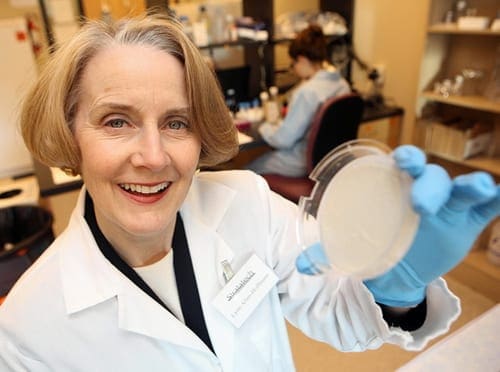
15 Feb UW-MADISON ECONOMIC IMPACT STARTS LOCALLY BUT SPREADS STATEWIDE
By Aaron Olver,
Managing Director – University Research Park, Inc.

Aaron Olver – URP Director
The University of Wisconsin – Madison just released its most recent economic impact report. The punchline: the University of Wisconsin – Madison has a $30 billion economic impact on Wisconsin. That’s about 9% of the economy and it means that 232,057 workers in Wisconsin have jobs generated by UW-Madison’s spending, research, contracts, students, visitors, startups and partnerships. I know it happens because I can see it from my window.
University Research Park is the most common location for University of Wisconsin – Madison spinouts to locate. They come for the specialized infrastructure, incubators like Forward BioLabs and the MGE Innovation Center, the ability to scale easily, a central location, and the community of 4,100 knowledge workers.

Stratatech Founder Lynn Allen Hoffmann
Stratatech is a classic example of how University of Wisconsin – Madison basic research alters lives and turns into jobs. Professor Lynn Allen-Hoffmann made a serendipitous discovery in her UW-Madison lab while studying human skin cells. She founded Stratatech to develop a skin substitute to treat burn victims without the need for painful and scarring grafts. With a WARF license and a small corner of a University Research Park lab, she went to work. Today, Stratatech has expanded to occupy a floor of our incubator, went through a successful acquisition by Mallinckrodt, is awaiting FDA approval, and partnered with us to build a new cleanroom manufacturing facility. They now employ people at two locations in the park.
And they aren’t alone. Cellular Dynamics was founded by UW Professor James Thomson to advance the potential of stem cell science. Today it’s part of Fujifilm and they just invested in a new cleanroom facility, their third location in the park, to drive that work forward. Nearby, Flugen is working on a vaccine for influenza – and now the Coronavirus – based on Professor Yoshihiro Kawaoka virus research which occurs in another nearby Research Park facility, the Influenza Research Institute .
Over at Forward BioLabs, Gregor Diagnostics is developing a prostate cancer diagnostic based on the work of David Jarrard. A Forward BioLabs graduate, BrainXell, is developing neuron cell technology developed at UW-Madison’s Waisman center by Professor Su-Chun Zhang. Dr. David O’Connor developed a screening test for Covid-19 from his University Research Park lab. Nearby, University Research Park just helped a new spinout of Roche, Nimble Therapeutics, build out a lab to advance peptide discovery. That technology was developed at UW-Madison in Professor Mike Sussman’s lab and commercialized by one of its inventors, Dr. Roland Green, who went on to co-found Invenra, another growing University Research Park startup.
University Research Park is in the business of creating neighborhoods where innovation can flourish. When these companies start, scale, and grow, they not only create jobs and hire Badgers (and import the very occasional Gopher or Wolverine), but it’s not long before they need more space. And when they do, the economic impact that began in the technology sector ripples far beyond it.

Exact Sciences Headquarters – Photo Credit: Steve Hall at Hall + Merrick
When we partner with a company to retrofit a lab or build a new facility, like we did for the Exact Sciences headquarters, we hire architects, engineers, and contractors. We need electricians, plumbers, carpenters, and iron workers. We pour concrete and asphalt, hang drywall, paint, carpet, and plant trees and bushes. We buy steel, elevators, chillers, boilers, generators, and building systems of all kinds. And then the company buys furniture, supplies, equipment, lighting, signs, computers, and art. And those vendors go on to hire people, spend money, and make investments that cascade further yet. That’s how UW-Madison helps generate $1 billion of tax revenue and accounts for 7% of Wisconsin’s jobs.
At the park, we are entrusted with a small corner of Madison, but the work University Research Park companies and the economic impact reaches far beyond. The economy – and University Research Park – is like a neighborhood. When your neighbors thrive, the whole community gets stronger, better, and more prosperous. My dollar spent is your dollar of income. The good news is that the University of Wisconsin – Madison is magnifying and multiplying the investment it receives and that is great news for everyone who calls a Wisconsin neighborhood home.


